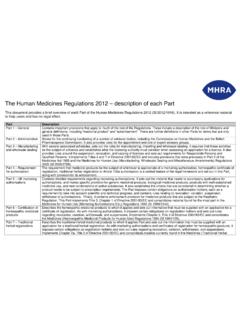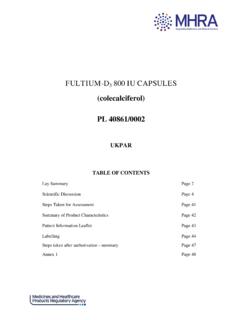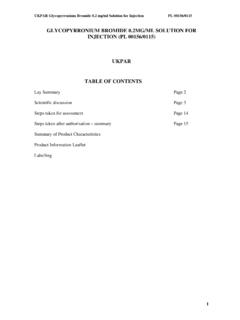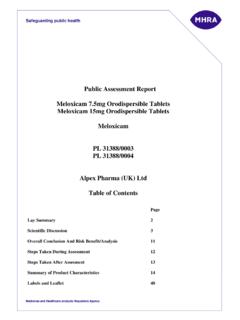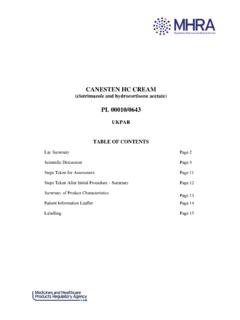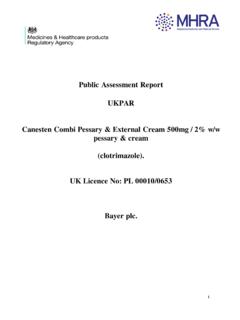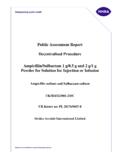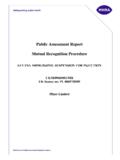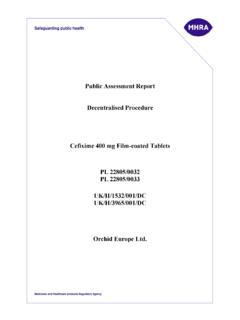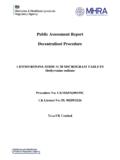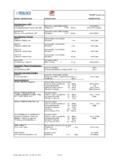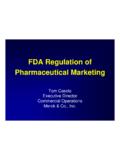Transcription of JULY 2013 Formulation switching of antiepileptic …
1 JULY 2013 A Report on the Recommendations of the Commission on Human Medicines from July 2013 Formulation switching of antiepileptic drugs Executive summary This report concerns CHM s recommendations on issues relating to brand/generic prescribing and switching between formulations for antiepileptic drugs (AEDs). There are particular concerns for AEDs because a number of them have a narrow therapeutic index and the consequences of therapeutic failure can be very severe. The practical and regulatory implications for the MHRA, the Pharmaceutical Industry and DH are identified and discussed. The paper includes proposals for: A categorisation of antiepileptic drugs by risk relating to Formulation switching Requirements for naming and presentation (labelling) of AEDs Handling parallel imported products and own label supplier products Suggested wording for the BNF Information for publication on the MHRA website CONTENTS Index Page 1.
2 Background 3 2. Practical and regulatory implications 5 3. A proposed categorisation of antiepileptic drugs by risk relating to Formulation switching 7 4. Suggested wording for the BNF 14 5. Proposed information for publication on MHRA website 15 1. Background Normally, if a generic medicinal product is shown to be bioequivalent to the innovator product, as defined by the relevant regulations and guidelines, it follows that the product should be considered to be clinically equivalent. Concerns have been raised that demonstration of bioequivalence, even according to the more stringent regulatory standards for drugs considered to have a narrow therapeutic index, might be insufficient to exclude the possibility of clinically important non-equivalence to the innovator product for certain antiepileptic drugs (AEDs). Therefore prescribing by specific named product might be necessary.
3 An ad hoc Expert Group of the Commission on Human Medicines was set up to consider a range of issues relating to brand/generic prescribing including, specifically, requirements for antiepileptic drugs. A review of a number of published studies on the issue of potential harm arising from generic substitution of AEDs did not show clear evidence of actual harm arising from switching formulations. However the lack of robust evidence of harm does not exclude the possibility that significant harm may sometimes occur, given the inherent limitations in the design of these mostly observational studies, as already reflected in the BNF with regard to phenytoin and carbamazepine, and more generally in the NICE AED guidance. The Group considered the bioequivalence rules that are applied to generic AEDs and the possible implications for clinical efficacy and safety of the differences in bioavailability of different formulations that were compatible with the regulations (including switching from branded originator to generic products and also between different generic products).
4 The Group also considered the significance of the solubility and permeability of the drug substance (BCS classification) in terms of its susceptibility to Formulation dependent differences in bioavailability. The Group expressed a view that in general terms there was a need to maintain continuity of supply of a specific product for certain AEDs. The specific product could be either a branded product or a generic. Continuity of supply from the same manufacturer was the key issue , rather than whether the product was branded or a generic. It was recognised that all AEDs are not the same in this respect. Problems related to small differences in bioavailability of different manufacturers products (branded, generic) are of concern for some drugs (most notably phenytoin) but not for some others that have a wider therapeutic index and/or high solubility and permeability.
5 In broad terms, three groups of AEDs were identified regarding concerns of the potential risk related to switching between products: AED Categorisation Category 1 - definite concerns phenytoin, carbamazepine Category 2 - possible concerns lamotrigine, topiramate, valproate Category 3 - unlikely to be concerns levetiracetam, lacosamide, pregabalin gabapentin The Group noted that the measures necessary to ensure the necessary continuity of supply should also consider the advice in the recently revised NICE guideline: "Consistent supply to the child, young person or adult with epilepsy of a particular manufacturer's AED preparation is recommended, unless the prescriber, in consultation with the child, young person, adult and their family and/or carers as appropriate, considers that this is not a concern. Different preparations of some AEDs may vary in bioavailability or pharmacokinetic profiles and care needs to be taken to avoid reduced effect or excessive side effects.
6 Consult the summary of product characteristics (SPC) and 'British national formulary' (BNF; available at ) on the bioavailability and pharmacokinetic profiles of individual AEDs, but note that these do not give information on comparing bioavailability of different generic preparations". Category 1 - need specific prescribing, supply and dispensing measures to ensure consistent supply of a particular product (for treatment of epilepsy only, not for neuropathic pain or other indications). This can be a specific brand leader (originator) product, a branded generic ( a generic approved with a brand name) or a specified manufacturer s generic product. Category 2 according to clinician's judgement, as per NICE guideline. Category 3 - no specific measures normally required. Acceptable to prescribe generically unless there is a reason not to ( patient anxiety, risk of confusion being caused by different preparations being taken leading to dosing errors).
7 The Group proposed that the BNF should be asked to include this guidance in the relevant section. The advice will need careful wording of text to ensure the message that continuity of supply from the same manufacturer is clearly stated to be the key issue rather than whether the product is branded or generic. There was agreement that terms such as branded generic should be avoided since this could lead to confusion . The Group queried whether computerised GP prescribing systems would allow the practitioner to select a specific manufacturer for a generic AED to ensure that consistency of supply was maintained. Subsequent discussion with Department of Health (DH) colleagues confirmed that current systems are capable of allowing this degree of specificity but that further investigation of the practicalities of introducing the proposed measures would be required.
8 It was noted that prescribing to maintain continuity of supply will already be occurring to some extent based on NICE guidance. At its meeting in March 2012 the Commission on Human Medicines (CHM) endorsed the recommendations of the Ad Hoc group in relation to AEDs. The CHM noted concerns regarding generic substitution of some medicinal products in this class, relating primarily to the very severe consequences of therapeutic failure and the narrow therapeutic index of certain AEDs. Another consideration is that, other than plasma drug level monitoring, there is no available clinical indicator to predict risk of seizures. An informal consultation with trade associations and industry was undertaken by the MHRA during 2012. It covered both general aspects concerning the practicalities of implementing measures to ensure continuity of supply of a specific product to patients and aspects specific to AEDs.
9 Based on the feedback received the measures proposed do appear to be workable in practice. A review of all currently approved AEDs was conducted by the MHRA with a view to categorising each into one of the three risk groups described above. By default drugs fell into category 2 unless the available information established either that there were particular issues necessitating the more robust measures for category 1, or that the risk of clinically significant differences between formulations was very low (category 3). 2. Practical and regulatory implications If the overarching proposal of maintaining the continuity of supply of AEDs based on categorisation principles and clinical judgement is adopted this would require some changes to the current regulatory procedures within the MHRA (including associated practical measures required of affected Marketing Authorisation Holders [MAH]) and DH prescribing systems.
10 The main practical and regulatory considerations are as follows: a) Product naming convention: MHRA Current naming convention in the UK allows for the product name to be (i) a brand name, or (ii) the international non-proprietary name (INN) or (iii) the INN + the name of the MAH (or distributor). Provided prescribing systems are enabled so that the different manufacturers of a particular generic can be selected at the point of prescribing then it might be possible that the current naming conventions could stand. Alternatively, the MHRA may consider it necessary to require that all generic products of AEDs are named as INN + MAH such that the need for continuity of supply of a particular manufacturer (as denoted by the brand name or presence of the MAH name) is made clear when prescribing at the product name level. This naming convention is consistent with Directive 2001/83/EC and EU practice and thus would have no wider implications.
